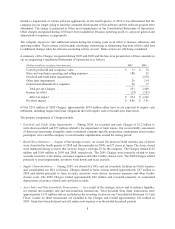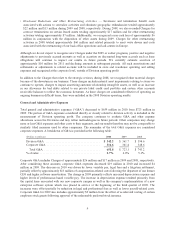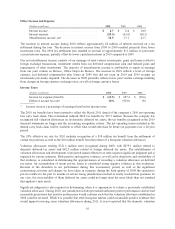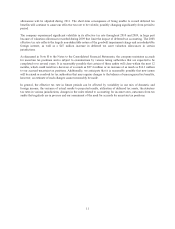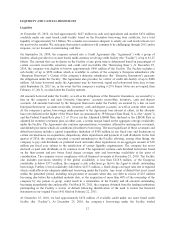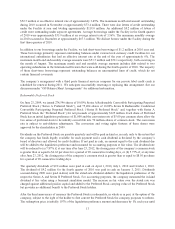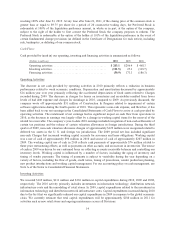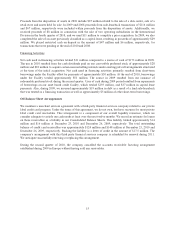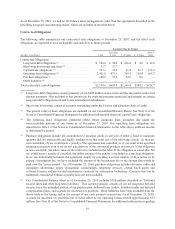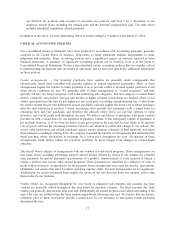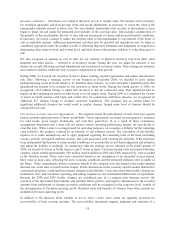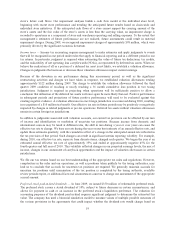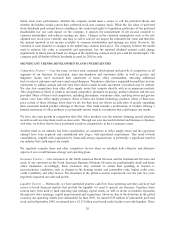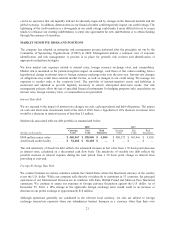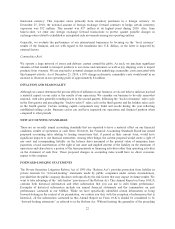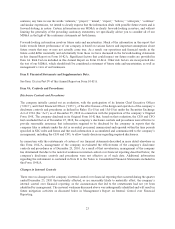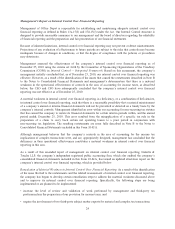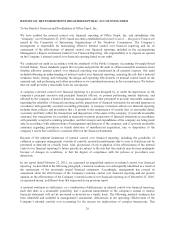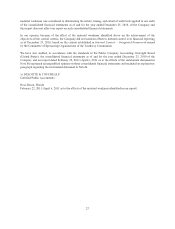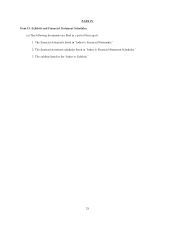Office Depot 2010 Annual Report Download - page 19
Download and view the complete annual report
Please find page 19 of the 2010 Office Depot annual report below. You can navigate through the pages in the report by either clicking on the pages listed below, or by using the keyword search tool below to find specific information within the annual report.Inventory valuation — Inventories are valued at the lower of cost or market value. We monitor active inventory
for excessive quantities and slow-moving items and record adjustments as necessary to lower the value if the
anticipated realizable amount is below cost. We also identify merchandise that we plan to discontinue or have
begun to phase out and assess the estimated recoverability of the carrying value. This includes consideration of
the quantity of the merchandise, the rate of sale, and our assessment of current and projected market conditions.
If necessary, we record a charge to reduce the carrying value of this merchandise to our estimate of the lower of
cost or realizable amount. Additional promotional activities may be initiated and markdowns may be taken as
considered appropriate until the product is sold or otherwise disposed. Estimates and judgments are required in
determining what items to stock and at what level, and what items to discontinue and how to value them prior to
sale.
We also recognize an expense in cost of sales for our estimate of physical inventory loss from theft, short
shipment and other factors — referred to as inventory shrink. During the year, we adjust the estimate of our
shrink rate accrual following on-hand adjustments and our physical inventory results. These changes in estimates
may result in volatility within the year or impact comparisons to other periods.
During 2008, we lowered our inventory levels to lessen working capital requirements and reduce obsolescence
risk. Also, following a strategic review of our business in December 2008, we decided to close certain
underperforming stores in North America. To facilitate these closures, we contracted with a liquidation firm that
guaranteed the amount to be realized for the inventory in those stores. During the fourth quarter of 2008, we
recognized a $15 million Charge to adjust that inventory to the net contracted value. That adjustment had no
impact on the remaining inventory in other stores or in our supply chain. During 2009, we completed the closure
of stores in North America and Japan and certain DCs. In conjunction with these closures, we recognized an
additional $13 million Charge to facilitate inventory liquidation. The company has no current plans for
significant additional closures that could result in similar charges, though some level of closures should be
anticipated each year.
Closed store accruals and asset impairments — We regularly assess the performance of each retail store against
historic patterns and projections of future profitability. These assessments are based on management’s estimates
for sales levels, gross margin attainments, and cash flow generation. If, as a result of these evaluations,
management determines that a store will not achieve certain operating performance targets, we may decide to
close the store. When a store is no longer used for operating purposes, we recognize a liability for the remaining
costs related to the property, reduced by an estimate of any sublease income. The calculation of this liability
requires us to make assumptions and to apply judgment regarding the remaining term of the lease (including
vacancy period), anticipated sublease income, and costs associated with vacating the premises. With assistance
from independent third parties to assess market conditions, we periodically review these judgments and estimates
and adjust the liability accordingly. In conjunction with the strategic review initiated in the fourth quarter of
2008, we closed 126 stores in North America and 27 stores in Japan. The lease-related costs associated with these
closures, which totaled approximately $89 million and $6 million in 2009 and 2008, respectively, were recorded
as the facilities closed. These costs were calculated based on our assumption of an extended vacancy period,
three years in most cases, reflecting the slow economic conditions and the estimated sublease rates available in
the future. These commitments with no economic benefit to the company were discounted at the credit-adjusted
discount rate at the time of each location closure. Future fluctuations in the economy and the market demand for
commercial properties could result in material changes in this liability. Costs associated with facility closures are
included in store and warehouse operating and selling expenses in our Consolidated Statements of Operations.
Because the 2008 and 2009 facility closures are considered part of a company-wide business review, the
accretion of the discounted lease liability and potential future positive and negative adjustments to the recorded
amounts from settlements or changes in market conditions will be recognized at the corporate level, outside of
the determination of Division operating profit. Residual costs and benefits of closures from other periods are
included in Division operating profit.
In addition to the decision about whether or not to close a store, store assets are regularly reviewed for
recoverability of their carrying amounts. The recoverability assessment requires judgment and estimates of a
18


